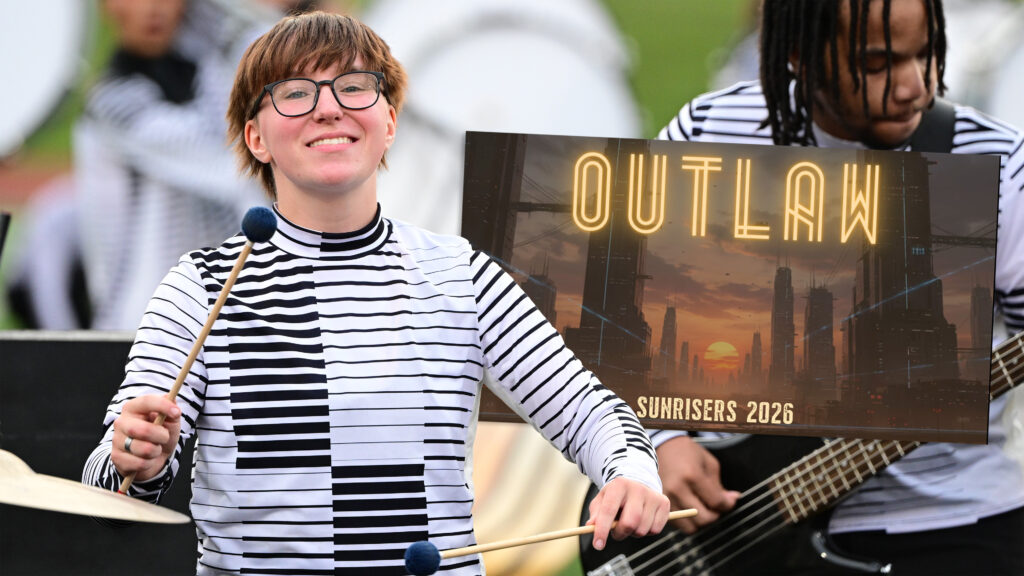
The one thing most fans probably remember about the 2000 Drum Corps International season was the tie for the title between the Cavaliers and Cadets. It was the third tie for the Championship in five years and the second in a row. Both the 5th place Boston Crusaders and 6th place Blue Knights celebrated their highest placements ever and Southwind was only two tenths of a point away from knocking the Bluecoats out of the Finals competition.
Santa Clara Vanguard’s 4th place “The Age of Reverence” opened with Samuel Barber’s “Prayers of Kierkegaard, No. 4,” the section from the one-movement cantata titled, “Father in Heaven! Hold Not Our Sins Up Against Us.” Barber wrote the piece for chorus, large orchestra, soprano solo and smaller tenor and alto vocal solos, basing it on writings of Søren Kierkegaard that included prayers and sermons created between 1847 and 1855. The Danish Kierkegaard, whose texts often dealt with personal responsibility, love and redemption, is credited with being the first existential philosopher. The work was written between 1942 and 1954, the long gap due to a variety of interruptions, including World War II. The piece was commissioned by the Koussevitzky Music Foundation, which was founded in 1942 by Serge Koussevitzky.
He was a Russian-born conductor and composer and director of the Boston Symphony Orchestra. Koussevitzky, a dedicated champion of modern music, commissioned a large number of important works from major composers, including B?©la Bartók’s “Concerto for Orchestra,” Aaron Copland’s “Symphony No. 3,” and Maurice Ravel’s famed orchestral orchestration of Modest Mussorgsky’s 1874 suite for piano, “Pictures at an Exhibition.” He’s also known as the person who taught conducting to Leonard Bernstein. At the start of Santa Clara Vanguard’s 2000 production, the brass players set up in a diagonal straight line from the lower left corner to the upper right corner of the field, facing backfield with the color guard section in a circular block and drums across the back.
The solemn chorale had the horns continually collapse toward where the guard began via a number of squiggling lines. By the end of the crescendoing chorale, the horns and drums filled into the circle left by the guard and the guard was now stretched diagonally across the field as the horns had been earlier.
Settling back into a contemplative, chant-like segment, the Barber piece segued into B?©la Bartók’s “String Quartet No. 4, mvt. 5, Allegro molto.” This work from 1927, like all the other works to follow, was originally written for chamber instrumentation—small groups of instruments as opposed to full orchestras.
It was radical for employing a variety of unconventional instrumental techniques not common to string literature. The primitive and brutal percussion forcefulness, often relying on accents in unexpected places, made this string work quite adaptable to the drum corps arena. Angular lines and tight blocks in the visual program reflected the musical mood, with brass players gyrating and creating angular choreography during the percussion break.
The above movement seamlessly evolved into Bartók’s 1926 “Piano Concerto No. 1, mvt. 3, Allegro molto.” Bartók went through a dry spell during the previous three years, breaking his compositional drought with a number of works for piano, often treating the piano like a percussion instrument. This work, seeming in its day as strangely non-melodic, was loaded with pounding dissonances that challenged the ears of the audience.
The third movement was conceived as an animated dance, furious in its tempo, exploring how the piano related to the percussion. The corps employed rapidly mutating curlicues to give this segment its own visual flavor. The next piece in the program returned to the music of Samuel Barber with “Agnus Dei,” meaning “Lamb of God,” a setting of the last part of the Latin Mass. The 1967 arrangement for male and female voices, with optional piano or organ accompaniment for support only, was set to Barber’s own “Adagio for Strings” from 1938. T
hat famous work was itself arranged for full string orchestra from the second movement of his 1936 “String Quartet, Op. 11.” The four parts, written for soprano, alto, tenor and bass, are often divided into further parts, giving the vocal piece a haunting richness that comes close to matching the ethereal resonance of the 1938 work for strings.
Related content: Adagio for Drum Corps Played largely without percussion, except for an occasional timpani roll and suspended cymbal roll—culminating with the entire snare line rolling on cymbals—the piece evolved at its climax to have color guard members furiously tossing equipment and spinning around as a lone guard member vigorously spun his rifle as if a whirling dervish.

The final selection in the program was two selections from “Stained Glass,” composed in 1991 for 12 percussionists and written by David Gillingham. “Foyers” and “Sun Catchers” are the first and third movements of the work, mixed in with each other throughout the production.
The show ended with a continuous repetition of the 12-note tone row that opened “Sun Catchers” in the original, fading into a reverent stillness. The color guard members condensed into a circular block in the lower right corner of the field and the horns, facing backfield, emanated out from the circle in a straight line heading toward the upper left corner. The drums were once again spread out across the back of the field.
The ending form was pretty much a mirror image of how the show began. As the mallets played the tone row, they faded into obscurity while the horn players laid down their instruments. One-by-one they spun around and grabbed onto each other, every member in a different pose, yet united by the reverence for a greater being that transcends all understanding.
For this week only, you can save on the DVD that contains this complete Blue Knights performance, along with all of the finalist corps at the 2000 DCI World Championship.
Buy the 2000 DCI World Championship DVD set. (Available this week only for 30% off. Regular price: $39.95.) Discount DVD offer ends Monday, April 28.

Michael Boo was a member of the Cavaliers from 1975-1977. He has written about the drum corps activity for more than a quarter century and serves as a staff writer for various Drum Corps International projects. Boo has written for numerous other publications and has published an honors-winning book on the history of figure skating. As an accomplished composer, Boo holds a bachelor's degree in music education and a master's degree in music theory and composition. He resides in Chesterton, Ind.





